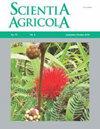Estimation of repeatability and genotypic superiority of elephant grass half-sib families for energy purposes using mixed models
IF 2.6
3区 农林科学
Q1 Agricultural and Biological Sciences
引用次数: 1
Abstract
: The mixed-model methodology is an alternative to select genotypes for traits highly influenced by the environment. In addition, this method allows FOR estimating the repeatability coefficient and predicting the number of assessments needed for a selection process to increase reliability. This study aimed to determine the minimum number of evaluations necessary for a reliable selection process and to estimate the variance components used for predicting genetic gains between and within half-sib families of elephant grass ( Cenchrus purpureus (Schumach.) Morrone ) using the mixed-model methodology. Half-sib families were generated using genotypes from the Active Germplasm Bank of Elephant Grass. The experiment was performed in a randomized block design with nine half-sib families, three replicates, and eight plants per plot. We evaluated 216 genotypes (individual plants) of elephant grass. The deviance analysis was carried out, genetic parameters were estimated, gains between and within families were predicted, and repeatability coefficients were obtained using Selegen software. There was genetic variability for selection within the families evaluated. The reliability values found above 60 % for plant height and number of tillers and above 80 % for dry matter yield suggest that only two evaluations are required to select superior genotypes with outstanding reliability. Sixteen genotypes were identified and selected for their productive potential, which can be used as parents in elephant grass breeding programs for bioenergy production.利用混合模型估计象草半同胞家族的可重复性和基因型优势
本文章由计算机程序翻译,如有差异,请以英文原文为准。
求助全文
约1分钟内获得全文
求助全文
来源期刊

Scientia Agricola
农林科学-农业综合
CiteScore
5.10
自引率
3.80%
发文量
78
审稿时长
18-36 weeks
期刊介绍:
Scientia Agricola is a journal of the University of São Paulo edited at the Luiz de Queiroz campus in Piracicaba, a city in São Paulo state, southeastern Brazil. Scientia Agricola publishes original articles which contribute to the advancement of the agricultural, environmental and biological sciences.
 求助内容:
求助内容: 应助结果提醒方式:
应助结果提醒方式:


